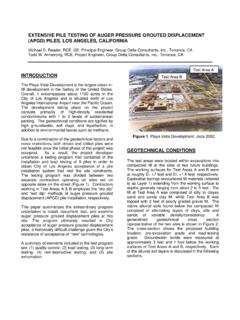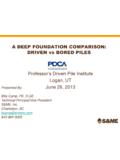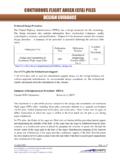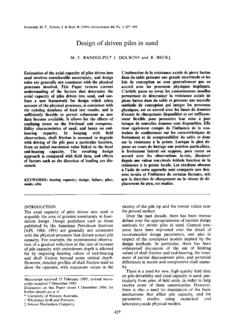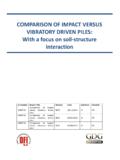Transcription of Vol. 6, Issue 7, July 2017 The Compression Bearing ...
1 ISSN(Online): 2319-8753 ISSN (Print): 2347-6710 International Journal of Innovative Research in Science, Engineering and Technology (An ISO 3297: 2007 Certified Organization) Website: Vol. 6, Issue 7, July 2017 Copyright to IJIRSET 12666 The Compression Bearing Capacity of Helical Piles in Black Cotton Soil , , , Uday Assistant Professor, Department of Civil Engineering, Global Academy of Technology, Bangalore, Karnataka, India1 Student, Department of Civil Engineering, Global Academy of Technology, Bangalore, Karnataka, India2 Student, Department of Civil Engineering, Global Academy of Technology, Bangalore, Karnataka, India3 Student, Department of Civil Engineering, Global Academy of Technology, Bangalore, Karnataka, India4 ABSTRACT.
2 Helical piles foundation systems have been extensively used in engineering application. Helical pile foundation system are commonly adapted to resists the Compression , uplift force, overturning moment and lateral forces. Now a day, helical pile foundation systems have become commonly adapted in many countries. The use of helical piles as a deep foundation option has considerably increased in the recent years to support variety of loads, from small loads for several applications such as residential housing, solar farms, and utilities and retrofit projects, to large loads for many applications such as commercial, power transmissions lines, oil facilities and industrial applications.
3 Therefore, it is necessary to know the axial Compression capacities of these piles under vertical loads, for this reason the aim of the work is to study how to improve the compressive capacities of helical pile in black cotton soil. Model steel piles with and without helical plate are embedded in black cotton soil are tested to study the effect of vertical loading on the behavior of piles in Compression . Laboratory experiments were conducted on the pile of 20mm diameter with and without helical plate and with varying helical plate diameters as 25mm, 45mm and 65mm respectively. KEYWORDS: Helical pile, Black cotton soil, Compressive load, Helix diameter.
4 I. INTRODUCTION The earliest helical anchor created by a blind English brick maker names Alexander Mitchell for designing a foundation support of a lighthouse in 1833. The concept of screw pile was very successful in the designing but the development of helical plate foundation was not progress. Until 1950 s, a power-installed screw anchor for resisting tension load was found in US and this type of anchor was starting popular and widely used in the construction site. The helical anchor formed by a steel shaft which one or more helical plates welded to the shaft to create a screw anchor . Helical anchors are primary designed and constructed to provide the Compression resistance to the foundation of a structure.
5 However, helical anchor system also can provide the uplift support to the structure. Helical pile model ISSN(Online): 2319-8753 ISSN (Print): 2347-6710 International Journal of Innovative Research in Science, Engineering and Technology (An ISO 3297: 2007 Certified Organization) Website: Vol. 6, Issue 7, July 2017 Copyright to IJIRSET 12667 In the construction site, the helical anchor are installed by applying a rotating and axial forces to the shaft of anchor and screw the anchor into the ground with power augering truck. The helical anchor can be installed rapidly and minimize the soil disturbance in the installation.
6 This anchor system always install to the maximum torque values that recommended by the manufacturers. The helical anchor system is not suitable for the foundation in stiff soil or soil containing gravel because the helixes may be damage in installation process. Therefore, this type of anchor system always applied in the sand, silt and clay. Advantages of Helical Pile Foundation Systems Type of deep foundation: Helical pile foundation systems are considered as deep foundation system. It can be adapted to the greater depth more than 2meters. Climatic conditions: Helical piles are suitable to all weather conditions and can be installed in high temperature weather and freezing temperatures.
7 Easy and Rapid Installation: Light weight helical piles can be easily installed with manually handled equipments and heavy weighted helical piles are easily and rapidly installed by using advanced equipments Such as mini-excavators, skid steers, backhoes and larger track. Equipments: For easy and fast installation of helical piles verity of equipments are with different sizes are Available in market according to the design loads, as well as limited space in site and also its access. Installation techniques without producing vibrations: Installation of modern helical piles does not produce any vibrations on ground, like traditional piles such as driven piles and some soil improvement techniques.
8 No curing and Immediate testing after installation: Helical piles does not require any curing period like drilled shaft piles and auger-cast piles after installation hence laboratory or field tests can be conducted immediately after the installation. Immediate placing of concrete after installation: Installed helical piles do not require any curing period. In case of major projects, the reinforcement and concrete is placed immediately after the helical pile installation which reduces construction time. II. LITERATURE RVIEW 1. 1st Recorded Helical Pile was by Alexander Mitchell (fig. 1) in 1836 for Moorings and then applied by Mitchell to Maplin Sands Light house in England in word has been followed up by several researchs.
9 Wilson has done a very good work on the Bearing capacity of these piles. Meyerhof suggested the Theory of plasticity for determining the Bearing capacity of helical piles . Skempton also suggested formulation to predict the capacity of the helical pile and reported field test results with supported the formulations. Mitchell s Helical Pile (2014): This paper aims at presenting the Compression and uplift Bearing capacities of helical piles in cohesion less soil and is to study how to improve the provision of the Compression and uplift capacities of the helical piles, and also studied the effect of embedment depth. From the laboratory tests results they concluded that the Compression and pullout resistance of helical piles is strongly affected by the area and composition of helical plates welded to the pile steel shaft.
10 From the laboratory results they concluded that the Compression and uplift load carrying capacities increases with increasing the embedment ratio (D/d). ISSN(Online): 2319-8753 ISSN (Print): 2347-6710 International Journal of Innovative Research in Science, Engineering and Technology (An ISO 3297: 2007 Certified Organization) Website: Vol. 6, Issue 7, July 2017 Copyright to IJIRSET 12668 and (1994): Based on the laboratory tests results, they indicated that there are three components mainly contribute to the uplift capacity of shallow anchor, which are the self weight of anchor, weight of sand within the failure surface and the friction along the failure surface.











